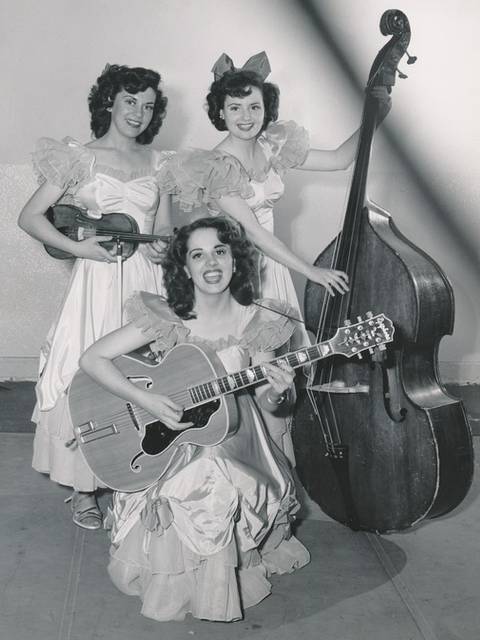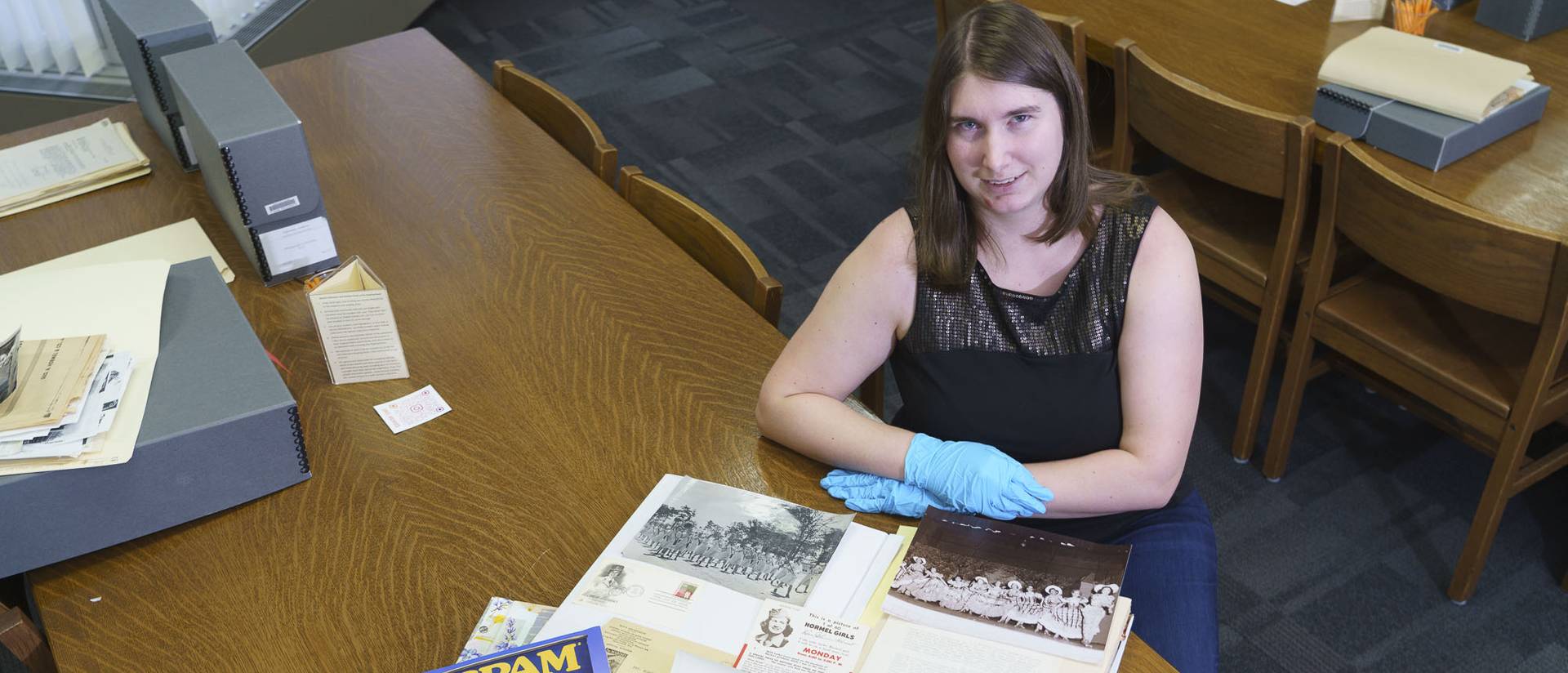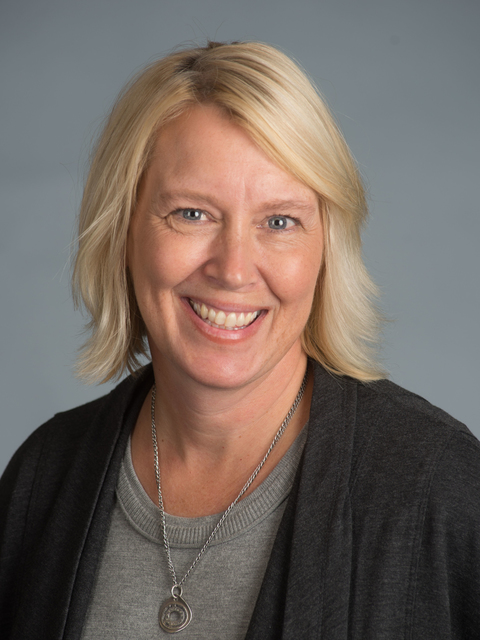Photo caption: History graduate student Kaitlin Augustine is among the Blugolds who used a collection the university recently acquired from a longtime Eau Claire resident to create a digital exhibit that tells the story of the Marine Corps Women’s Reserve Band during WWII and the Hormel Girls Caravan created after the war. The women in the musical groups earned their own money, helping to change gender expectations and societal norms in the 1940s and 1950s. (Photo by Bill Hoepner)
After teaching social studies in classrooms across the country for several years, Jonathan Vega knew he wanted to do even more to connect his students and others with history.
Now a first-year public history graduate student at the University of Wisconsin-Eau Claire, Vega already is finding ways to do just that by sharing interesting pieces of history with people of all ages.
This fall, Vega and a team of Blugolds created a digital exhibit that tells the story of a group of pathbreaking women — including Eleanor Jones, a Chippewa Valley native and longtime Eau Claire resident — who challenged societal norms and gender expectations in the years following World War II.
“Being able to bring these rich stories and experiences out for everyone to enjoy and learn from is an amazing feeling,” says Vega, a native of Bronx, New York. “The exhibit is a peek at a piece of both local and national history.”
Vega, history graduate student Kaitlin Augustine and 24 UW-Eau Claire undergraduate students in a public history class taught by Dr. Cheryl Ana Jiménez Frei, assistant professor of history, created the exhibit as a class project. Working with Jiménez-Frei, they researched archival materials before writing and installing the digital exhibit.
The exhibit, “Marching Beyond the Kitchen: SPAM and Women Behind the Can,” tells the story of the Hormel Girls, a band of female WWII veterans who toured the U.S. selling Hormel Company products, the most well-known of which was SPAM.
“The exhibit tells a fascinating story, far beyond what might first come to mind when most people think of SPAM,” Jiménez-Frei says. “The women at the center of the exhibit — most prominently, Eleanor Jones — bring forth a story of early feminism and breaking barriers, at a time when societal expectations of women were quite strict, and opportunities limited.”

The Hormel Girls, a band of female WWII veterans, toured the U.S. selling Hormel products.
The popular troupe traveled the country in the 1940s and 1950s, marketing Hormel products to American consumers. They traveled from coast to coast in a caravan of white Chevys, selling products in grocery stores, ringing doorbells and performing in popular national radio and TV specials.
This new approach to sales — using young and talented women who epitomized the beauty standards of the era to sell products — forever changed the world of advertising.
"They had to conform to prescribed standards of beauty for the time and ignore comments and treatment that today we would recognize as demeaning or sexist," Jiménez-Frei says. "But at the same time, these women seized an opportunity to shatter other societal expectations of women. They traveled, had consistent, well-paid employment that provided more freedom, and many — like Eleanor Jones — rejected the expectation that women should marry, have children and become homemakers. Eleanor led a very different life and defied many barriers put in front of women at the time.”
The Hormel women represented a larger cultural shift in societal norms and gender expectations in the U.S., offering an early glimpse of a burgeoning feminist movement. By working and earning their own salaries, the women achieved financial independence, allowing them to buy cars, clothing, dinners and gifts for their families, all things not possible for most women during that era.
Acquired collection offers learning opportunities
Last year, UW-Eau Claire’s Special Collections and Archives at McIntyre Library acquired a significant collection of letters, photos and recordings from Jones, a trombonist who enlisted in the Marine Corps, joining a group of women who formed the inaugural Marine Corps Women’s Reserve Band. After the war, she was part of Hormel’s first caravan troupe.
The acquisition is “one of the most important collections in the United States” documenting the Hormel Girls Caravan, says Greg Kocken, UW-Eau Claire archivist. The materials include correspondence, scrapbooks, photographs, artifacts and materials associated with other band members. The collection also includes an oral history interview with Jones.
“The project encapsulates the exciting work that we do in the field of public history, and the work we train students to do in our public history program,” Jiménez-Frei says. “In public history courses, it is important for students to have experiences where they can apply the methods they have learned in a collaborative field project. What you see is the product of that, of our impressive history students utilizing their skills — in research, analysis, writing and exhibit planning — to bring a story to life and share it with a wider audience.”
The students had only four weeks to complete the project in all its phases: research, analysis, exhibit design, group editing, interactive features and implementation, Jiménez Frei says. She’s proud of her students’ work and the exhibit they created, she says.
“Eleanor Jones is an extraordinary woman who has led an extraordinary life, and I think the students have honored her and the significance of her story well,” Jiménez-Frei says.
The exhibit reflects the extraordinary work Blugolds are doing in the digital humanities, Kocken says. For example, the students included many integrated components, such as a timeline and story map, that enhance the exhibit, he says.
“The students were presented with a great learning experience and challenge,” Kocken says. “They were asked to develop and curate a significant exhibit within a short time. They definitely rose to the challenge and produced something fantastic.”
Vega says it was exciting to sift through the many archival resources in the collection as they worked to find creative ways to share stories about Jones and the traveling musical groups.
“This was someone who had an amazing story to tell from such an interesting moment in history, and we were able to help bring that story to the world,” Vega says of Jones. “It’s from these kinds of stories that we can paint more complete pictures of many moments in history.”
Jones, who worked for Eau Claire radio and television stations and later for the UW-Extension, has been involved with UW-Eau Claire in various ways, including visiting university classrooms to share her stories. She and her friend Grace Shipley, a member of the Hormel caravan who later taught English at UW-Eau Claire, established the Grace Shipley and Eleanor Jones Scholarship with the UW-Eau Claire Foundation.
Augustine, a second-year graduate student from Ellsworth, says the Hormel project helped her appreciate the significant time and effort it takes to create an exhibit for the public. She better understands the process that must be followed and the standards that must be met before exhibits can be shared.
“In my public history class, we learned the theoretical approach to creating exhibits, but this was the first real-world project I’ve done,” Augustine says. “By creating an actual exhibit, I learned the practical applications. From this experience, I’ll take with me the knowledge of the importance of collaboration and research in creating interpretations of history.”
The knowledge he gained from creating the digital exhibit will help him be more successful in the future, says Vega, who hopes to work in museum education and then someday teach history at a university.
“I learned from this project that this type of work in public history can be difficult but also incredibly rewarding,” Vega says. “Bringing rich stories and experiences out for everyone to enjoy and learn is an amazing feeling. I shared the exhibit with my family, and they absolutely loved learning more about something they had never heard before.”
Augustine, who “can’t remember a time when history did not fascinate me,” says working on the Hormel exhibit gave her the practical experience she needs to be successful in the field of public history. She’s now eager to explore the multiple subfields in public history that interest her, including archival work, curating in museums and becoming a college history professor.
Vega, who will work as an intern with the Chippewa Valley Museum this spring, says opportunities to be part of real-world projects are among the reasons he came to UW-Eau Claire for his graduate studies.
“I chose UWEC because of the opportunities and experiences that this program could provide,” Vega says. “The opportunities for internships and the potential to work with some outstanding professors also drew me to this program. Everything they do sets up students for future success.”

